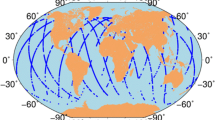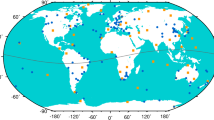Abstract
With the development of real-time precise clock and orbit products, high-precision real-time ionospheric products have become one of the most critical resources for real-time single-frequency precise point positioning. Fortunately, there are several international GNSS service (IGS) analysis centers, e.g., UPC, WHU, and CAS, that are providing real-time global ionospheric maps (RT-GIMs). We evaluate these maps in detail over 2 years for different aspects. First, the RT-GIMs and 1-day predicted ionospheric products (C1PG GIM) differenced with the IGS final GIMs (IGSG GIM) are performed. Second, ionospheric vertical total electron content from Jason-2/3 data is set as a reference to evaluate the quality of RT-GIMs over oceanic regions. Third, 22 stations, which are not used in the generation of RT-GIMs, C1PG GIM, and IGSG GIM, are selected and the difference of slant total electron content (dSTEC) method is used to assess the accuracy and consistency of RT-GIMs over continental regions. Finally, the performance of RT-GIMs in the position domain is demonstrated based on SF-PPP solutions. The results show that the accuracy of the RT-GIMs is slightly worse than that of C1PG GIM and IGSG GIM. All RT-GIMs and the C1PG GIM have a smaller mean difference compared to the IGSG GIM by (−0.97, − 0.90, − 0.77, − 0.80) TECU for (UPC RT-GIM, CAS RT-GIM, WHU RT-GIM, C1PG GIM). Over oceanic regions, the RT-GIMs perform nearly the same as the C1PG GIM, but a slightly worse than IGSG GIM. The STDs are (3.96, 3.05, 3.25, 3.12, 2.54) TECU relative to Jason-2 and (4.94, 3.24, 3.38, 3.24, 2.65) TECU relative to Jason-3 for (UPC RT-GIM, CAS RT-GIM, WHU RT-GIM, C1PG GIM, IGSG GIM), respectively. Comparing with dSTEC values observed from the selected ground stations over continental regions, the RMS is (4.02, 2.16, 2.29, 1.86, 1.49) TECU for (UPC RT-GIM, CAS RT-GIM, WHU RT-GIM, C1PG GIM, IGSG GIM). In the position domain, the positioning accuracy of SF-PPP solution corrected by the RT-GIMs and C1PG GIM can reach decimeter level in the horizontal direction and meter level in the vertical direction, which is worse than obtained by IGSG GIM. Meanwhile, the positioning accuracy of SF-PPP corrected by RT-GIMs is almost the same as that obtained using C1PG GIM. For RT-GIMs, the accuracy of the CAS RT-GIM is slightly better than that of the other two RT-GIMs.
















Similar content being viewed by others
Explore related subjects
Discover the latest articles, news and stories from top researchers in related subjects.References
Angrisano A, Gaglione S, Gioia C, Massaro M, Robustelli U (2013) Assessment of NeQuick ionospheric model for Galileo single-frequency users. Acta Geophys 61(6):1457–1476
Bi T, An J, Yang J, Liu S (2017) A modified Klobuchar model for single-frequency GNSS users over the polar region. Adv Space Res 59(3):833–842
Brunini C, Azpilicueta F (2010) GPS slant total electron content accuracy using the single layer model under different geomagnetic regions and ionospheric conditions. J Geod 84(5):293–304
Brunini C, Azpilicueta F, Gende M, Camilion E, Ángel AA, Hernández-Pajares M, Juan M, Sanz J, Salazar D (2011a) Ground- and space-based GPS data ingestion into the NeQuick model. J Geod 85(12):931–939
Brunini C, Camilion E, Azpilicueta F (2011b) Simulation study of the influence of the ionospheric layer height in the thin layer ionospheric model. J Geod 85(9):637–645
Chen J, Huang L, Liu L, Wu P, Qin X (2017) Applicability analysis of VTEC derived from the sophisticated Klobuchar model in China. ISPRS Int J Geo-Inf 6(3):75
Choy S (2009) An investigation into the accuracy of single frequency precise point positioning (PPP). Ph.D. thesis, RMIT University, Australia
Ciraolo L, Azpilicueta F, Brunini C, Meza A, Radicella SM (2007) Calibration errors on experimental slant total electron content (TEC) determined with GPS. J Geod 81(2):111–120
Davies K (1990) Ionospheric radio. Peter Perrgrinus Ltd., London
Feltens J (2003) The activities of the Ionosphere working group of the International GPS Service (IGS). GPS Solut 7(1):41–46
Feltens J, Angling M, Jackson-Booth N, Jakowski N, Hoque M, Hernández-Pajares M, Aragón-Àngel A, Orús R, Zandbergen R (2011) Comparative testing of four ionospheric models driven with GPS measurements. Radio Sci 46(6):RS0D12
García-Rigo A, Monte E, Hernández-Pajares M, Juan JM, Sanz J, Aragón-Angel A, Salazar D (2011) Global prediction of the vertical total electron content of the ionosphere based on GPS data. Radio Sci 46(6):RS0D25
Hadas T, Bosy J (2015) IGS RTS precise orbits and clocks verification and quality degradation over time. GPS Solut 19(1):93–105
Hernández-Pajares, M. et al. (2019) Recent UPC-IonSAT results on global RT and other ionospheric modelling problems. Presentation at the 10th China satellite navigation conference (CSNC2019), Beijing, May 2019
Hernández-Pajares M, Juan JM, Sanz J, Orús R, Garcia-Rigo A, Feltens J, Komjathy A, Schaer SC, Krankowski A (2009) The IGS VTEC maps: a reliable source of ionospheric information since 1998. J Geod 83(3–4):263–275
Hernández-Pajares M, Roma-Dollase D, Krankowski A, García-Rigo A, Orús-Pérez R (2017) Methodology and consistency of slant and vertical assessments for ionospheric electron content models. J Geod 91(12):1405–1414
Hoque MM, Jakowski N (2015) An alternative ionospheric correction model for global navigation satellite systems. J Geod 89(4):391–406
Hoque MM, Jakowski N (2018) Berdermann J (2018) Positioning performance of the NTCM model driven by GPS Klobuchar model parameters. J Space Weather Space Clim 8:A20
Imel DA (1994) Evaluation of the TOPEX/POSEIDON dual-frequency ionosphere correction. J Geophys Res: Oceans 99(C12):24895–24906
Jee G, Lee HB, Kim YH, Chung JK, Cho J (2010) Assessment of GPS global ionosphere maps (GIM) by comparison between CODE GIM and TOPEX/Jason TEC data: ionospheric perspective. J Geophys Res Space Phys 115(A10):319
Kazmierski K, Sośnica K, Hadas T (2017) Quality assessment of multi-GNSS orbits and clocks for real-time precise point positioning. GPS Solut 22(1):11
Keshin M (2012) A new algorithm for single receiver DCB estimation using IGS TEC maps. GPS Solut 16(3):283–292
Klobuchar JA (1987) Ionospheric time-delay algorithm for single-frequency GPS users. IEEE Trans Aerosp Electron Syst 23(3):325–332
Komjathy A (1997) Global ionospheric total electron content mapping using the global positioning system. Ph.D. dissertation, Department of Geodesy and Geomatics Engineering, Technical report no. 188, University of New Brunswick, Fredericton, Canada
Li M, Yuan Y, Wang N, Li Z, Huo X (2018a) Performance of various predicted GNSS global ionospheric maps relative to GPS and JASON TEC data. GPS Solut 22:55
Li X, Xie W, Huang J, Ma T, Zhang X, Yuan Y (2018b) Estimation and analysis of differential code biases for BDS3/BDS2 using iGMAS and MGEX observations. J Geod 93(3):419–435
Mannucci AJ, Wilson BD, Yuan DN, Ho CH, Lindqwister UJ, Runge TF (1998) A global mapping technique for GPS-derived ionospheric total electron content measurements. Radio Sci 33(3):565–582
Nava B, Coïsson P, Radicella SM (2008) A new version of the NeQuick ionosphere electron density model. J Atmos Terr Phys 70(15):1856–1862
Nie Z, Yang H, Zhou P, Gao Y, Wang Z (2019) Quality assessment of CNES real-time ionospheric products. GPS Solut 23:11
Orús R, Hernández-Pajares M, Juan JM, Sanz J, Garcı́a-Fernández M (2002) Performance of different TEC models to provide GPS ionospheric corrections. J Atmos Terr Phys 64(18):2055–2062
Orús R, Hernández-Pajares M, Juan J, Sanz J (2005) Improvement of global ionospheric VTEC maps by using kriging interpolation technique. J Atmos Solar-Terr Phys 67(16):1598–1609
Ren X, Zhang X, Xie W, Zhang K, Yuan Y, Li X (2016) Global ionospheric modelling using multi-GNSS: BeiDou, Galileo, GLONASS and GPS. Sci Rep 6:33499
Roma D, Hernandez M, Garcia-Rigo A, Laurichesse D, Schmidt M, Erdogan E, Yuan Y, Li Z, Gómez-Cama JM, Krankowski A (2016) Real time global ionospheric maps: a low latency alternative to traditional GIMs. In: 19th International Beacon satellite symposium (BSS 2016), Trieste, Italy, June 27–July 1, p 1
Roma-Dollase D, Hernández-Pajares M, Krankowski A, Kotulak K, Ghoddousi-Fard R et al (2018) Consistency of seven different GNSS global ionospheric mapping techniques during one solar cycle. J Geod 92(6):691–706
Schaer S (1999) Mapping and predicting the earth’s ionosphere using the global positioning system. Ph.D. thesis, Institut für Geodäsie und Photogrammetrie, Eidg. Technische Hochschule Zürich
Schaer S, Gurtner W, Feltens J (1998) IONEX: the ionosphere map exchange format version 1. In: Proceedings of the IGS AC workshop, Darmstadt, Germany, vol 9
Wang N, Yuan Y, Li Z, Montenbruck O, Tan B (2016) Determination of differential code biases with multi-GNSS observations. J Geod 90(3):209–228
Wang N, Li Z, Min L, Yuan Y, Huo X (2018) GPS, BDS and Galileo ionospheric correction models: an evaluation in range delay and position domain. J Atmos Terr Phys 180:83–91
Wang N, Li Z, Yuan Y, Li M, Huo X, Yuan C (2019) Ionospheric correction using GPS Klobuchar coefficients with an empirical night-time delay model. Adv Space Res 63(2):886–896
Yuan Y, Huo X, Ou J, Zhang K, Chai Y, Wen D, Grenfell R (2008) Refining the Klobuchar ionospheric coefficients based on GPS observations. IEEE Trans Aero Electron Syst 44(4):1498–1510
Yunbin Y, Ningbo W, Zishen L, Xingliang H (2019) The BeiDou global broadcast ionospheric delay correction model (BDGIM) and its preliminary performance evaluation results. Navigation 66(1):55–69
Yunck TP (1993) Coping with the atmosphere and ionosphere in precise satellite and ground positioning, Washington DC. Am Geophys Union Geophys Monogr Ser 73:1–16
Zhang X, Ma F, Ren X, Xie W, Zhu F, Li X (2017) Evaluation of NTCM-BC and a proposed modification for single-frequency positioning. GPS Solut 21(4):1535–1548
Zhang L, Yang H, Gao Y, Yao Y, Xu C (2018) Evaluation and analysis of real-time precise orbits and clocks products from different IGS analysis centers. Adv Space Res 61(12):2942–2954
Acknowledgements
This research was funded by the National Science Fund for Distinguished Young Scholars (Grant no. 41825009), the Hubei Province Natural Science Foundation of China (no. 2018CFA081), the National Youth Thousand Talents Program, the Funds for Creative Research Groups of China (Grant No. 41721003), the National Key Research and Development Program of China (nos. 2016YFB0501803, 2017YFB0503402), National Natural Science Foundation of China (nos. 41774034, 41774030), the project of Wuhan Science and Technology Bureau (No. 2018010401011270), China Scholarship Council (CSC, file 201806275029), Key Laboratory of Geospace Environment and Geodesy, Ministry of Education, Wuhan University (no. 18-02-02), and Guangxi Key Laboratory of Spatial Information and Geomatics (no. 17-259-16-05). The numerical calculations were done on the supercomputing system in the Supercomputing Center of Wuhan University. We are very grateful to the Crustal Dynamics Data Information System (CDDIS) data center for providing 1-day predicted GIMs, final GIMs, observation data, and navigation file by the following FTP server: ftp://cddis.gsfc.nasa.gov/gnss/pro-ducts/ionex/and ftp://cddis.gsfc.nasa.gov/pub/gps/data/daily/. The data of the Jason-2/3 altimetry are available via the FTP server: ftp://data.nodc.noaa.gov/pub/data.nodc/. The data of the RT-GIMs products of different IAACs are collected by the Chinese Academy of Sciences and can available via the FTP server: ftp://gipp.org.cn/product/ionex. In addition, we also gratefully acknowledge the use of Generic Mapping Tool (GMT) software.
Author information
Authors and Affiliations
Corresponding authors
Additional information
Publisher's Note
Springer Nature remains neutral with regard to jurisdictional claims in published maps and institutional affiliations.
Rights and permissions
About this article
Cite this article
Ren, X., Chen, J., Li, X. et al. Performance evaluation of real-time global ionospheric maps provided by different IGS analysis centers. GPS Solut 23, 113 (2019). https://doi.org/10.1007/s10291-019-0904-5
Received:
Accepted:
Published:
DOI: https://doi.org/10.1007/s10291-019-0904-5




